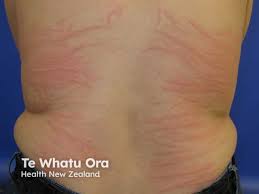Jasper Therapeutics’ briquilimab, a novel antibody therapy targeting KIT (CD117), performed well in a Phase 1b/2a study of chronic inducible urticaria (CIndU).
The research, which was presented at the European Academy of Allergy and Clinical Immunology (EAACI) Annual Congress in Glasgow, UK, showed that 11 of 12 CIndU participants enrolled in the 180mg cohort achieved a complete response and 12 of 12 participants (100%) in the 180mg cohort achieved a clinical response within the 8-week preliminary analysis period.
The observed efficacy was rapid and durable, with 8 of 12 participants (66%) achieving a clinical response by Week 2 and seven of 12 participants (58%) maintaining this response through Week 8. Briquilimab continued to be well tolerated in the study, with no serious adverse events (SAEs) and no grade 3 or higher adverse events (AEs) reported in the 180mg cohort.
The SPOTLIGHT study is a Phase 1b/2a open-label clinical trial evaluating a single dose of subcutaneous briquilimab in adult participants with cold urticaria (ColdU) or symptomatic dermographism (SD), the two most prevalent subtypes of CIndU, who are refractory to antihistamines. The study enrolled 27 participants across three dose cohorts: 40mg (n = 3), 120mg (n = 12), and 180mg (n = 12). The primary endpoints are safety and tolerability of briquilimab and secondary endpoints are focused on clinical activity and pharmacokinetics (PK)/pharmacodynamics (PD) including measurement of serum tryptase.
Among the 12 participants enrolled in the 180mg cohort, three were diagnosed with ColdU (25%) and nine with SD (75%). Participants had high disease burden as assessed by provocation threshold testing. In the 180mg cohort, mean baseline TempTest threshold was 18.7°C (range: 10-26°C) for ColdU participants, and mean baseline FricTest threshold was 3.7 of 4 (range: 3-4) for SD participants.
Twelve of 12 participants (100%) enrolled in the 180mg dose cohort achieved a clinical response to provocation testing within the 8-week preliminary analysis period following treatment. Eleven of 12 participants (92%) treated in the cohort achieved a complete response (CR) with either their critical temperature threshold improving to at least 4°C for ColdU participants or their FricTest score improving to 0 for SD participants, and 1 of 12 participants achieved a partial response (PR) as their best response. Complete responses in TempTest or FricTest were observed as early as 1 week following dosing in the 180mg cohort, with eight of 12 participants (66%) achieving CR or PR by Week 2.
Overall, 22 of 27 participants (81%) enrolled in the study achieved a CR, and 26 of 27 participants (96%) achieved a CR or PR. At the 8-week time point following treatment, seven of 12 (58%) participants in the 180mg cohort maintained an ongoing clinical response, with five participants achieving a complete response (CR) and two participants achieving a partial response (PR).
Mean baseline serum tryptase for participants in the 180mg cohort was 5.1ng/mL (standard deviation: 2.29ng/mL). Significant reductions in tryptase were observed as early as the week 1 assessment and were correlated with the onset of clinical responses. Tryptase measurements below the lower limit of quantification were observed in 10 of 12 participants (83%) in the 180mg cohort.
Briquilimab was well tolerated in the study. No serious adverse events (SAEs) or adverse events (AEs) ≥ grade 3 were reported in the 180mg cohort. Furthermore, there were no reported AEs related to hair or skin color changes. Two of the 12 participants (17%) enrolled in the 180mg cohort experienced a taste change or hypogeusia. Mild, transient drops in neutrophil counts were observed, with six of 12 participants (50%) experiencing grade 1 or grade 2 neutrophil count decreases, which resolved in a median of 16 days. Five of the six participants who experienced a decrease in neutrophil count were diagnosed with concurrent viral infections that may have contributed to the observed decrease.
“It is exciting to see additional clinical data showing that treatment with briquilimab can lead to deep clinical benefit shortly after administration in a difficult-to-treat antihistamine refractory CIndU patient population,” says Study Author Martin Metz, M., Professor of Dermatology and Allergy Charité – Universitätsmedizin Berlin, in a news release. “Notably, the safety and tolerability results observed in both the SPOTLIGHT and BEACON studies thus far show that the adverse events possibly caused by briquilimab are mostly low frequency, low grade, and resolve quickly. Patients with CIndU currently have very few treatment options, and I look forward to continuing to support the development of novel therapeutics to treat this debilitating disease.”
Dose-Escalation Study
The BEACON Study was a Phase 1b/2a dose-escalation study of the safety, pharmacokinetic/pharmacodynamic, and preliminary clinical activity of briquilimab in adults with symptomatic chronic spontaneous urticaria (CSU).
|
|
Briquilimab |
Briquilimab |
Briquilimab |
Briquilimab |
|
Complete Response, n (%) |
1 (33.3%) |
10 (83.3%) |
11 (91.6%) |
22 (81.5%) |
|
ColdU, n |
0 |
3 |
3 |
6 |
|
Symptomatic Dermographism, n |
1 |
7 |
8 |
16 |
|
Partial Response, n (%) |
2 (66.7%) |
1 (8.3%) |
1 (8.4%) |
4 (14.8%) |
|
ColdU, n |
1 |
0 |
0 |
1 |
|
Symptomatic Dermographism, n |
1 |
1 |
1 |
3 |
|
Complete or Partial Response at any time, n (%) |
3 (100%) |
11 (91.6%) |
12 (100%) |
26 (96.3%) |
|
|
PHOTO CREDIT: DermNet


